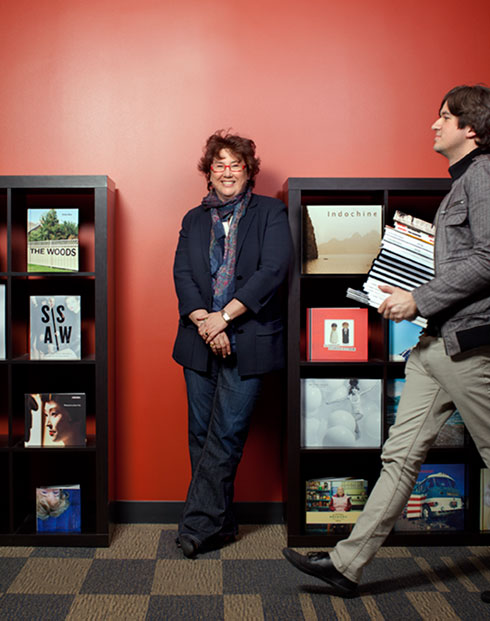by Rachel Howard
How Eileen Gittins turned the page and launched a new chapter in publishing.

Photograph by Cody Pickens
In 2004, after running two Silicon Valley tech start-ups and selling one of them, Eileen Gittins (B.A., '80) wanted to self- publish a book, but she wanted it to be beautiful.
A passionate photographer since her days as an art major at SF State, Gittins had found post-company "catharsis" by taking portraits of her former employees. "I realized it was a community project, and I wanted to share it with that group," she recalls. "I didn't think a link, a website, felt like a gift. How could I share this in a substantial way" The physicality and weight of a book feels so much more emotionally substantial."
But the options for producing a professional-quality photo book were expensive and complicated, requiring large print runs and elaborate distribution chains. "I thought "Wow, that's broken"," Gittins says. "And as an entrepreneur, you're looking for big markets of underserved users " that's called industry disruption."
So she spent more than a year studying the mechanics of book publishing, developing online software to let customers drag-and-drop images into sophisticated templates, and discovering that printers could still turn a profit publishing small batches of books if guaranteed a steady stream of ready-for-the-presses orders.
The resulting company was Blurb, which last year shipped two million books to more than 70 countries on five continents. As CEO, Gittins leads 107 employees at Blurb's San Francisco headquarters, with a smaller staff in London. At peak volume, Blurb publishes 1.1 books per second.
Gittins attributes her success to understanding the needs of her creative clientele " after all, she is her own target customer. She credits SF State classes with professors Jack Welpott and Catherine Wagner for arming her with the technical skills that both nurtured her artistry and also equipped her to become a top marketing executive at Eastman Kodak in the '90s. Her SF State mentors were "committed," she remembers " but her fellow students inspired her the most.
Gittins transferred to SF State after her mother's death, needing to support herself. "When you're faced with "I need more flexibility in my schedule," SF State is a great solution," she says, "and the tuition was affordable. I could work full time and go to school full time." She worked in the Macy's menswear department and later in a frame shop, while studying printmaking, painting, drawing and screenwriting. At the frame shop, she took some of her pay in materials to mat her works.
"I have an appreciation for people of privilege being able to attend college without working " I respect that," she says. "Of course it's wonderful. But if you don't have that luxury, your level of dedication is more acute. You have to make the decision that you're going to get your degree " you have to make it happen. A lot of people who go to State fit into that universe of making that active choice."
That appreciation of self-motivation drives her decision-making. "When I interview people now, I ask "What was your first paying job?"" she says. "And if they say they scooped ice cream when they were 16 " I'm sold."
Gittins is often in the position of making new hires lately, as Blurb's customer base continues to grow. Hobbyists still use Blurb to share their work with family and friends, but also corporate marketing divisions make promotional books instead of PowerPoint presentations, and serious artists use it to produce exhibition catalogues. In response, Blurb's new ProLine offers advanced design templates and high-end papers. "The color fidelity and color management was a huge investment," Gittins says.
She likes to say that Blurb was "born of personal pain," but today it brings her pure pleasure. "I still photograph all the time," she says. "And now every day I get to see fantastic work coming in. This company, for me, is a marriage of all the things I love and love to do."